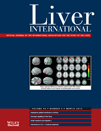Liver disease in adult transfusion-dependent beta-thalassaemic patients: investigating the role of iron overload and chronic HCV infection
Correspondence
Dimitrios Kountouras
2nd Department of Internal Medicine
“Hippokration” General Hospital
Medical School, University of Athens,
114 Vas. Sofias Avenue, Athens,
11521 Greece
Tel.: +30 210 6442085
Fax: +30 210 6442017
e-mail: [email protected]
Abstract
Background
Iron overload and hepatitis-C virus (HCV) infection, have been implicated in the evolution of liver disease, in patients with transfusion-dependent beta-thalassaemia major (BTM). However, the impact of these factors in late stages of liver disease in adults with BTM, has not been extensively studied.
Aims
To investigate serum indices of iron overload, HCV infection and liver disease, in a cohort of 211 adult Greek patients with BTM, in relation with the findings from liver biopsies.
Methods
In this cross-sectional study, 211 patients with BTM were enrolled and studied, in relation with HCV infection, ferritin, transaminases, chelation treatment and antiviral treatment. Based on 109 patients biopsied, we correlated liver fibrosis, haemosiderosis and inflammation, with serum indices and HCV status
Results
Among all patients, 74.4% were anti-HCV positive (HCV+). Ferritin was positively correlated with transaminases and negatively correlated with age, while it was not significantly different among HCV+ and HCV− patients. Among the HCV+ patients, 55.4% reported antiviral treatment, while genotype 1 predominated. In a subfraction of 109 patients, in which liver biopsy was performed, 89% were HCV+ and 11% HCV−. Fibrosis was significantly correlated with age (P = 0.046), AST (P = 0.004), ALT (P = 0.044) and inflammation (P < 0.001). Advanced fibrosis was present with even minimal haemosiderosis, independently of ferritin values or HCV history.
Conclusions
These data suggest that in the late stages of liver disease in BTM patients, iron overload may be the critical determinant, since fibrosis is related to the minimal haemosiderosis, independently of HCV history.




